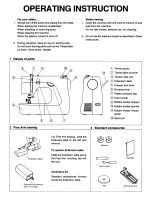
Buttonhole Stitching/Button Sewing
91
3
— — — — — — — — — — — — — — — — — — — — — — — — — — — — — — — — — — — — — — — — — — — — — — — — — — — —
CAUTION
■
Changing the density of the stitching
Adjust the stitch length.
Memo
z
For details, refer to "Adjusting the stitch
length" (page 62).
z
If the fabric does not feed (for example, if it
is too thick), decrease the density of the
stitching.
■
Changing the stitch width
Adjust the stitch width.
Memo
z
For details, refer to "Adjusting the stitch
width" (page 61).
z
Before sewing buttonholes, check the stitch
length and width by sewing a trial
buttonhole on a scrap piece of fabric.
■
Sewing buttonholes on stretch fabrics
When sewing buttonholes on stretch or loosely
woven fabrics, use a gimp thread.
a
Hook the gimp thread onto the part of
buttonhole foot "A" shown in the illustration.
b
It fits into the grooves, and then loosely tie it.
c
Attach buttonhole foot "A".
• For details on replacing the presser foot, refer
to "Replacing the presser foot" (page 43).
d
Select stitch
52
or
53
.
e
Adjust the stitch width to the thickness of the
gimp thread.
f
Lower the presser foot lever and the
buttonhole lever, and then start sewing.
g
When sewing is finished, gently pull the gimp
thread to remove any slack.
h
Use a handsewing needle to pull the gimp
thread to the wrong side of the fabric, and
then tie it.
●
When opening the buttonhole with the
seam ripper, do not place your hands in
the cutting path, otherwise injuries may
result if the seam ripper slips.
●
Do not use the seam ripper in any other
way than how it is intended.
Содержание 885-V35
Страница 50: ...48 GETTING READY ...
Страница 174: ...172 EMBROIDERY ...
















































